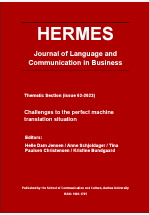Introduction to thematic section: Challenges to the perfect machine-translation situation
DOI:
https://doi.org/10.7146/hjlcb.vi63.143077Keywords:
machine translation, literary translationAbstract
The purpose of the thematic section is to gauge the temperature of MT today by tapping into a selection of critical discussions, thereby shedding light on some challenges to a perfect machine-translation (MT) situation.
References
Asimakoulas, D. (2016). Aristophanes in Comic Books: Adaptation as Metabase. Meta, 61(3), 553–577.
Bella, G., Helm, P., Koch, G. & Giunchiglia, F. (2023). Towards Bridging the Digital Language Divide. https://arxiv.org/pdf/2307.13405.
Christensen, T. P., Bundgaard, K., Schjoldager, A., & Dam Jensen, H. (2022). What Motor Vehicles and Translation Machines Have in Common—A first step towards a translation automation taxonomy. Perspectives. Studies in Translation Theory and Practice, 30(1), 19-38.
European Commission (2014). Translation and Intellectual Property Rights: Final Report. Luxembourg: European Union.
Farkas, A. & Németh, R. (2022). How to measure gender bias in machine translation: Real-world oriented machine translators, multiple reference points. Social Sciences & Humanities Open, 5(1), 1-11.
Feuerriegel, S., Hartmann, J., Janiesch, C. & Zschech, P. (2023). Generative AI. Business & Information Systems Engineering, https://doi.org/10.1007/s12599-023-00834-7.
Forcada, M. L. (2023). Licensing and usage rights of language data in machine translation. In H. Moniz & C. Parra Escartín (Eds.), Towards responsible machine translation: Ethical and legal considerations in machine translation (pp. 49–69). Springer.
Forcada, M. L. (2020). Building machine translation systems for minor languages: challenges and effects. Revista de Llengua i Dret, Journal of Language and Law, 73, 1-20.
Friedman, B. & Nissenbaum, H. (1996). Bias in computer systems. ACM Transactions on Information Systems (TOIS), 14(3), 330–347.
Guerberof-Arenas, A., & Toral, A. (2022). Creativity in translation: machine translation as a constraint for literary texts. Translation Spaces, 11(2), 184-212.
Hadley, J.L., Taivalkoski-Shilov, K., Teixeira, C.S.C. & Toral, A. (2022). Introduction. In J.L. Hadley, K. Taivalkoski-Shilov, C.S.C. Teixeira, & A. Toral (Eds.), Using Technologies for Creative-Text Translation (pp. 1-17). Routledge.
Hartley, T. (2009). Technology and translation. In Munday, J. (Ed.), The Routledge companion to translation studies (pp. 106–127). Routledge.
Katan, D. (1999/2004). Translating Cultures, An Introduction for Translators, Interpreters and Mediators. Jerome Publishing.
Klimova, B., Pikhart, M., Benites, A.D. Lehr, C. & Sanchez-Stockhammer, C. (2022). Neural machine translation in foreign language teaching and learning: a systematic review. Education and Information Technologies.
Koponen, M., Nyqvist, S., & Taivalkoski-Shilov, K. (2022). Translating with technology: How digitalisation affects authorship and copyright of literary texts. In J. L. Hadley, K. Taivalkoski-Shilov, C. S. C. Teixeira, & A. Toral (Eds.), Using Technologies for Creative-Text Translation (pp. 180–198). Routledge.
Lacruz Mantecón, M.L. (2023). Authorship and Rights Ownership in the Machine Translation Era. In Moniz, H., Parra Escartín, C. (Eds.), Towards Responsible Machine Translation. Machine Translation: Technologies and Applications, 4. Springer, Cham.
Martino, A., Iannelli M. and Truong, C. (2023). Knowledge Injection to Counter Large Language Model (LLM) Hallucination. In C. Pesquita et al. (Eds.), The Semantic Web: ESWC 2023 Satellite Events. ESWC 2023. Lecture Notes in Computer Science, 13998. Springer, Cham.
Miernicki, M., Ng, I. (Huang Ying) (2021). Artificial intelligence and moral rights. AI & Society, 36, 319–329.
Moniz, H., Escartín, C.P. (2023). Introduction. In H. Moniz & C. Parra Escartín (Eds.), Towards Responsible Machine Translation. Machine Translation: Technologies and Applications, 4. Springer, Cham.
Moorkens, J. & Lewis, D. (2020). Copyright and the Reuse of Translation as Data. In M. O’Hagan (Ed.), The Routledge Handbook of Translation and Technology (pp. 469-481). Routledge.
Nord, C. (2018). Translating as a purposeful activity: Functionalist approaches explained. Routledge.
O’Brien, S. & Ehrensberger-Dow, M. (2020). MT Literacy – A cognitive view. Translation, Cognition & Behavior, 3(2), 145-164.
O’Thomas, M. (2017). Humanum ex machina: Translation in the post-global, posthuman world. Target, 29(2), 284–300.
Quora (n.d.) [online]. https://www.quora.com/Can-machine-translation-fully-dominate-and-replace-human-translators?top_ans=241036765
Savoldi, B., Gaido, M., Bentivogli, L., Negri, M. & Turchi, M. (2021). Gender Bias in Machine Translation. Transactions of the Association for Computational Linguistics, 9, 845–874.
Slessor, S. (2020). Tenacious technophobes or nascent technophiles? A survey of the technological practices and needs of literary translators. Perspectives, 28(2), 238-252.
Tieber, M. (2022). Perfect MT and the Concept of Translation. Abstract HAL panel at NeTTT Conference, 4-6 July 2022, Rhodes Island, Greece.
Topping, S. (2000). Sharing translation database information: Considerations for developing an ethical and viable exchange of data. Multilingual Computing and Technology, 11(5), 59– 61.
Toral, A. & Way, A. (2018). What Level of Quality can Neural Machine Translation Attain on Literary Text? In J. Moorkens, S. Castilho, F. Gaspari & S. Doherty (Eds.), Translation Quality Assessment. From Principles to Practice (pp. 263-287) Springer.
Ullmann, S. (2022). Gender Bias in Machine Translation Systems. In Hanemaayer (Ed.), Artificial Intelligence and Its Discontents, Social and Cultural Studies of Robots and AI (pp. 123-144). Springer Nature.
World Intellectual Property Organization (WIPO) (n.d.): Berne Convention for the Protection of Literary and Artistic Work [online]. https://www.wipo.int/treaties/en/ip/berne/.
Yamada, M. (2023). Optimizing Machine Translation through Prompt Engineering: An Investigation into ChatGPT’s Customizability. https://arxiv.org/abs/2308.01391.

Downloads
Published
How to Cite
Issue
Section
License
Copyright (c) 2024 Helle Dam Jensen, Anne Schjoldager, Tina Paulsen Christensen, Kristine Bundgaard

This work is licensed under a Creative Commons Attribution 4.0 International License.
Authors who publish with this journal agree to the following terms:
a. Authors retain copyright and grant the journal right of first publication with the work simultaneously licensed under a Creative Commons Attribution License that allows others to share the work with an acknowledgement of the work's authorship and initial publication in this journal.
b. Authors are able to enter into separate, additional contractual arrangements for the non-exclusive distribution of the journal's published version of the work (e.g., post it to an institutional repository or publish it in a book), with an acknowledgement of its initial publication in this journal.
c. Authors are permitted and encouraged to post their work online (e.g., in institutional repositories or on their website) prior to and during the submission process, as it can lead to productive exchanges, as well as earlier and greater citation of published work (See The Effect of Open Access).




